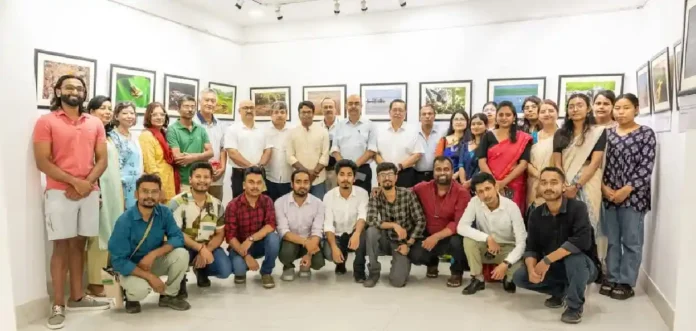
Nature lovers and photography enthusiasts gathered in Guwahati for a visual spectacle. The Assam wildlife photography exhibition brought together 46 captivating images from across the Northeast, offering a vivid portrayal of the region’s ecological wealth.
The State Art Gallery in Guwahati hosted this memorable event. Organized by the Assam State Biodiversity Board in collaboration with nature groups and photographers, the exhibition aimed to celebrate biodiversity while spreading awareness about conservation. Notably, it attracted a wide audience that included students, tourists, and professionals alike.
Read More: Northeast Deserves a Beach: Pradyot Bats for Clarity
Guwahati Welcomes Nature Through the Lens
Far beyond a typical photo display, the exhibition featured detailed stories behind each photograph. These stories described the species, the location, and the environmental challenges affecting the subjects. For example, one image captured the rare clouded leopard of Arunachal Pradesh, while another showed the iconic one-horned rhinoceros of Kaziranga in its natural habitat.
To select the final images, organizers launched a statewide open call. Amateur and professional photographers from all over the Northeast submitted their best wildlife captures. Eventually, a panel of conservationists and photography experts handpicked 46 entries based on quality, rarity, and storytelling impact.
According to Dr. Bibhab Kumar Talukdar, a respected wildlife conservationist and guest speaker at the event, “This Assam wildlife photography exhibition goes beyond visuals—it builds a deeper connection between people and the wild.”
Visual Narratives from a Diverse Ecosystem
The Northeast’s terrain spans lush rainforests, alpine meadows, wetlands, and high-altitude zones. As a result, the region supports a remarkable variety of life forms. This diversity took center stage at the exhibition. Visitors saw vibrant photographs of birds, butterflies, big cats, amphibians, and lesser-known mammals.
The exhibition also featured compelling night photography. Stunning shots of owls, porcupines, and civets under moonlight revealed the hidden lives of nocturnal creatures. Each image included coordinates, species names, and camera settings, making the display not only beautiful but also educational.
In addition, short video clips and behind-the-scenes footage allowed visitors to appreciate the effort that goes into wildlife photography. Many photographers waited hours—or even days—to capture the perfect moment in the wild.
Exhibition Inspires Conservation Conversations
Importantly, the event served as a platform for meaningful discussions on conservation. Several side sessions addressed issues like habitat loss, climate change, and the increasing frequency of human-wildlife conflict. Environmental scientists and activists led talks that drew in curious minds of all ages.
One workshop encouraged young visitors to participate in biodiversity mapping through citizen science apps. Another interactive session taught school children how to document nature through journaling and sketching, creating a lasting impression of the exhibition’s goals.
According to event coordinator Nayanika Deka, “The mission behind the Assam wildlife photography exhibition is clear—we want people to become more curious, informed, and active about conservation.”
The exhibition emphasized that real change often starts with awareness. By engaging the public through art and storytelling, organizers hoped to spark deeper interest in protecting the region’s wildlife.
The Assam wildlife photography exhibition in Guwahati stood out for more than its aesthetic value. It delivered a strong message: conservation must be part of our everyday conversation. Through the lens of talented photographers, the wild came to life—stirring awe, curiosity, and concern.
In today’s fast-changing environment, events like this play a crucial role. They help people see what’s at stake and why it matters. As one visitor said, “These photos don’t just show nature—they make you feel responsible for it.”
The exhibition might be over, but its impact will last. It reminded everyone that the Northeast’s beauty deserves both admiration and protection—frame by frame, step by step.
Read More: Karnataka CM Hails Banu Mushtaq’s Booker Win



